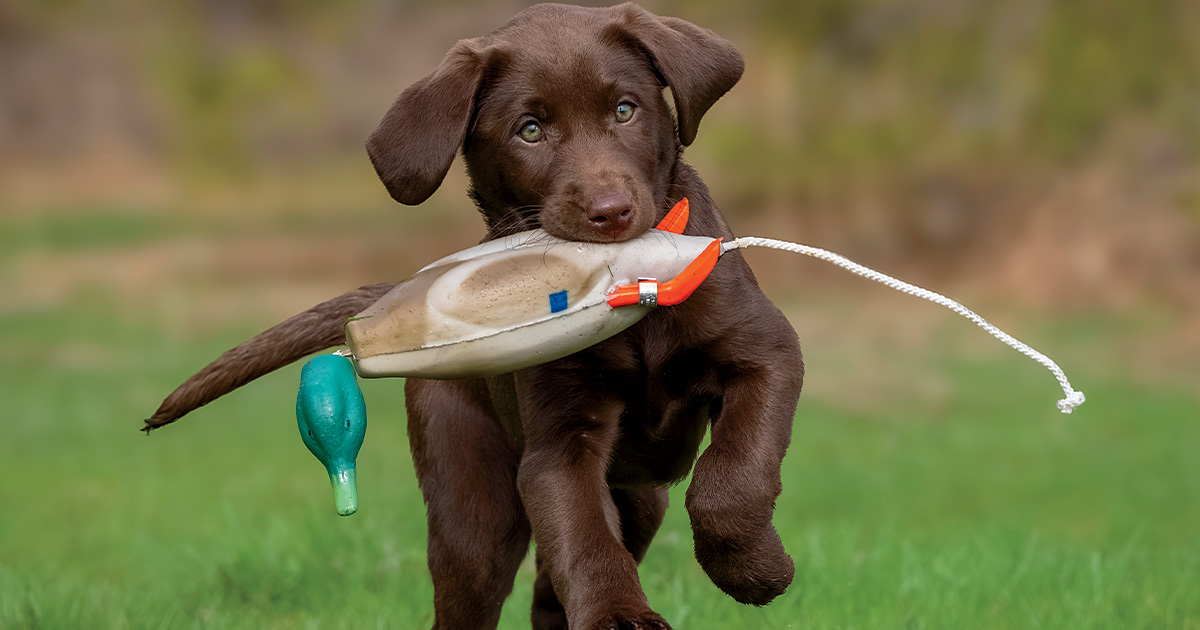Training Days
Keep your retriever healthy with expert tips on exercise, heat stress, and first aid for a successful hunting season
Keep your retriever healthy with expert tips on exercise, heat stress, and first aid for a successful hunting season


Regular exercise is key to keeping a retriever in shape during the off-season.
Like human athletes, retrievers must be in top physical condition to perform at a high level in the field. The following five tips from a veterinarian will help you keep your retriever fit over the summer months so he will be in top form on opening day.
As a veterinarian and avid hunter who specializes in sporting dogs, Dr. Joe Spoo says that regular exercise is key to keeping a retriever in shape during the off-season. “A dog that is overweight and not in good physical condition is much more prone to injuries,” Spoo says. “That is especially true early in the hunting season, when the heat can be an issue.”
Going for walks or runs, swimming, and summer training sessions are all good ways to keep your dog in shape, and Spoo says to match the amount and type of food you are feeding to your dog’s activity level.
“Keep an eye on your dog’s body condition throughout the off-season and adjust accordingly,” Spoo says. “These dogs are so amazingly athletic, but we can’t expect them to spend months eating too much and not getting enough exercise and then perform at a high level. That’s when injuries occur.”
One of the most common concerns for retrievers is hyperthermia, or over-heating, and Spoo says a dog will let you know when he is becoming too hot. “Panting is how a dog cools himself, and that panting really changes when the dog is overheated,” he says. “The tongue is going to be way out of his mouth, and the tongue will get really wide to try to create more surface area to cool down. The dog’s breathing will also start to sound raspy, and he will often have ropes of saliva coming out of his mouth because he’s not taking the time to swallow.”
To prevent heat-related illnesses, Spoo recommends keeping your dog hydrated before and during warm weather training sessions and giving him plenty of breaks to rest and cool down. It’s also best to limit training to the early morning hours in especially hot weather.
Many injuries go undetected while in the field, which is why Spoo recommends ending a hunt or training session with a tailgate exam, which is something that dog owners of all ages can help perform. “My daughter, Grace, is too young to hunt, but she loves to help me take a look at our dogs once we are back at the truck and sitting on the tailgate. We look at the eyes and ears, the chest, armpits, and groin—those common areas where wounds can occur,” Spoo says.
Whether he is hunting or training, Spoo always has a pair of first-aid kits with him: a basic kit for use in the field and a more extensive kit in the truck.
“The kit I carry with me in the field is very simple. It includes a bottle of saline solution for rinsing eyes or wounds and some flexible cling wrap and gauze that I can use to cover and stabilize a wound,” he says.
The larger kit contains a thermometer, a pair of needle-nose pliers or a multi-tool, tweezers, a surgical stapler for closing larger wounds, triple antibiotic ointment for wounds and the eyes, cotton-tip swabs, and hydrogen peroxide to induce vomiting if the dog ingests something dangerous.
“Even as a veterinarian, I am not going to try and do anything major out in the field or back at the truck,” Spoo says. “The goal is to stabilize a wound or injury so I can get the dog back to town for proper care.”
Lastly, Spoo says an important part of keeping your retriever healthy is simply knowing when enough is enough. “There are obvious signs like a significant injury or wound or coming up lame or limping, but you should also pay attention to the eyes. You can look at a dog’s eyes, and they will tell you if he has had enough and it’s time to shut things down,” Spoo says.
It’s also important to remember, Spoo adds, that a dog experiences conditions in the field differently than people do. “Take an August goose hunt or September dove hunt for example. We might think it’s not that hot out there, but the dog may be down in the wheat stubble or other cover where it’s hot and miserable. Be mindful of what conditions are like at dog level.”
Ducks Unlimited uses cookies to enhance your browsing experience, optimize site functionality, analyze traffic, and deliver personalized advertising through third parties. By continuing to use this site, you agree to our use of cookies. View Privacy Policy